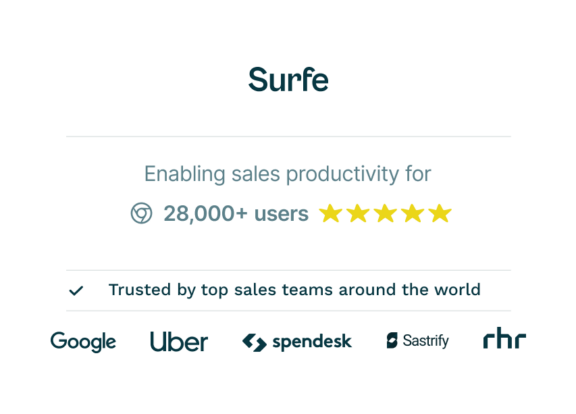Technographic Data: Find Which Tools Your Competitors Are Using

Meet Nigel.
Nigel is a salesperson who’s always being pipped to the post by this one competitor. And by always, we mean always.
Every month he gets to the final decision-making stage. Every month he receives the message “Sorry, we’ve decided to go with the alternative.”
After a year of disappointment, Nigel’s had enough – so he decides to do everything in his power to bring his competitor down (or at least, you know, stop constantly losing out on deals to them).
His first step? Reading this article, which, as you’re about to find out, explains why understanding a competitor’s tech stack may be the secret weapon every sales pro needs.
After reading, Nigel uses Surfe to dig into his competitor’s technographic data – and something magical happens. He optimizes his own tech stack, starts sending more personalized pitches, becomes a master of partnership strategies, and stays ahead of industry trends.
He starts winning deals left, right, and center – and everyone at his competitor is left scratching their heads in confusion.
Want the same results as Nigel? Sure you do. Here’s what we’re going to cover today:
- What is Technographic Data?
- Why Understanding Your Competitors’ Tools Matters
- How to Find Technographic Data with Surfe
- What Should You Do Once You Know Which Tools Your Competitors Are Using?
Ready to be more Nigel? Keep reading.
What is Technographic Data?
First things first, what actually is technological data?
In a nutshell, it’s information about the technologies a company uses – what software they rely on, what platforms they work from, and what other tools make up their day-to-day.
For example, you might look at a business’s technographic data and discover its team uses Salesforce as their CRM, ActiveCampaign for marketing automation, and Zendesk for analytics.
Technographic data is all about operations. Firmographic data is more about finding out traditional details about a business – for example, industry size, its location, or how much money it makes – whereas technographics give you an insight into how the business actually works.
In other words, it’s a pretty important insight that can tell you a lot.
Why Understanding Your Competitors’ Tools Matters
Ok, so we know what technographic data is. But why would you actually want to use it to find out what technologies your competitors use?
Quite a lot of reasons, it turns out:
Competitive Intelligence: competitors’ tools reveal their strategy, how efficient they are, and what areas they’re focussing on.
Benchmarking: is your competitor using a tool you’ve considered adding to your roster? Or maybe your tech stack is way, way bulkier than theirs? Benchmarking can be a useful way of figuring out where you fall short, or where you’re ahead.
Market positioning: technographic insights can help you position your business uniquely in the market. If a tool reveals a certain strategy, for example, you can do something different to stand out.
Let’s take an example. Nigel, when scoping out his competitor, finds out they use multiple lead enrichment tools. This is pretty standard – 9 in 10 companies use more than one. This makes Nigel 1) feel smug, as he uses Surfe which does everything he needs, and 2) understand that his competitor is relying heavily on outbound sales.
Clever Nigel. Let’s find out how you can find similar insights with Surfe.
How to Find Technographic Data with Surfe
Spoiler alert: this is really, really easy.
- Sign up for Surfe – you can try it for free!
- Head on over to the Company Search feature.
- Search for your competitor.
- Once they come up, scroll across to the ‘Technologies’ column. There, you should see a list of all the tools your competitor uses.
- You can also reverse this process, by applying the ‘Technologies’ filter when searching for companies. For example, apply a HubSpot filter and only businesses that use HubSpot will pop up.
Told you it was easy. Next up – what do you actually do with all that information?

What Should You Do Once You Know Which Tools Your Competitors Are Using?
Let’s dig a little deeper into how Nigel used technographic data to (figuratively) destroy his opponent.
First of all, he optimized his tech stack. He realized that his competitor was using a few tools that he hadn’t heard of. He played around with them and found a couple dramatically improved his speed and efficiency – two things which are, as we know, crucial in sales.
Next up, he started really personalizing sales pitches using what he found. By checking out the tech stack of businesses he was going after, he was able to tell what type of features they were looking for and what problems they were looking to solve. He then made sure to put those front and center in his pitches.
Remember how we mentioned Nigel became a partnerships master? Well, here’s how. His product integrates with another, well-known player in the market. He used Surfe to find out which companies were using this well-known player and then targeted them, mentioning the ease the integration would bring as a key selling point.
Nigel also started getting so ahead of industry trends that his colleagues started to suspect he was a mind-reader. By keeping an eye on which businesses were using what tools, he was able to understand their current needs. When large swathes of his industry started adopting a certain new tool, he realized it indicated a new priority – which he then used to tailor his messaging.
And that is how Nigel used Surfe to become a star salesman – and get his sweet, sweet revenge on his competitor. He doesn’t even think about them anymore. That’s how successful he is.
Let’s Wrap It Up!
Be more Nigel.
Here’s the thing: becoming a star salesperson doesn’t involve complicated strategies or uncanny amounts of luck.
Instead, it just involves being clever with the data that’s out there and available to you. Use Surfe to help you find technographic data, and you’ll be up there on the podium with Nigel in no time. See you there!

Woah, does Nigel have a twin?
Either that, or we see another clever sales pro using Surfe. Wanna join them?
FAQs About Spotting Which Tools Your Competitors Are Using
What Is Technographic Data And Why Is It Useful?
Technographic data provides insights into the technologies a company uses – like its CRM, analytics tools, or marketing automation platforms, to name a few. This data helps you understand how businesses operate behind the scenes. For example, knowing your competitor relies on a specific tool for sales automation can highlight their priorities and strategies.
When you have this information, you can optimize your own tech stack, personalize outreach, and even predict trends within your industry. It’s like seeing the playbook your competition uses to win deals. Leveraging this insight can transform how you position yourself in the market.
How Can I Identify The Tools My Competitors Are Using?
Finding out which tools your competitors use is easier than you might think with Surfe. Here’s how:
- Sign up for Surfe and navigate to the Company Search feature.
- Search for a competitor.
- Scroll to the “Technologies” column to view their tech stack.
You can also filter companies by specific tools, such as HubSpot, to see which businesses are using that technology. This simple process gives you the upper hand in understanding your competitor’s operational strategies.
How Does Technographic Data Help Improve My Tech Stack?
Technographic data can help you refine your tech stack into something special. By comparing your tools with those of your competitors, you can identify gaps or inefficiencies. For instance, if a competitor uses a tool that boosts sales team productivity, it’s worth exploring how adopting or improving a similar tool could benefit your team.
This benchmarking process ensures your operations are competitive and optimized for efficiency. Plus, it helps you avoid investing in unnecessary tools, keeping your stack lean and impactful.
Can Technographic Data Help Me Personalize My Sales Pitches?
Yes! Technographic data lets you tailor your messaging based on what your prospects or competitors are using. For example, if a potential client uses a specific CRM, you can highlight how your product integrates seamlessly with it.
By aligning your pitch with their existing tools and workflows, you demonstrate that you understand their needs. This makes your pitch more relevant and increases your chances of closing the deal.
How Can Technographic Insights Help Me Stay Ahead Of Industry Trends?
Keeping tabs on which tools your competitors and prospects are adopting can signal emerging trends. For example, if many companies in your sector begin using a particular tool, like an AI-powered analytics tool for example, it could indicate a shift in priorities.
By recognizing these trends early, you can adjust your strategy to stay ahead – whether that’s integrating with similar tools, addressing new pain points, or pivoting your messaging to align with industry shifts.
How Does Surfe Simplify Competitive Analysis?
Surfe makes competitive analysis straightforward by providing direct access to technographic data. You can use its Company Search feature to pinpoint your competitors’ tools, filter by specific technologies, and gather actionable insights.
This not only saves time but also empowers you to make data-driven decisions for your sales strategy. Whether it’s improving your tech stack, creating targeted pitches, or identifying partnership opportunities, Surfe gives you everything you need to stay competitive.


